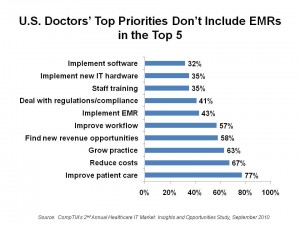 Improving patient care, reducing practice costs, growing revenues and attracting new patients are top-of-mind for a majority of doctors in the U.S. What about electronic medical records (EMRs)? Not so high on physicians’ priority lists, according to the second annual health IT survey conducted in July 2010 by CompTIA.
Improving patient care, reducing practice costs, growing revenues and attracting new patients are top-of-mind for a majority of doctors in the U.S. What about electronic medical records (EMRs)? Not so high on physicians’ priority lists, according to the second annual health IT survey conducted in July 2010 by CompTIA.
When it comes to spending on health information technology, group practices told CompTIA they plan to spend more in 2011, whereas solo practices will keep IT spending flat.
Among doctors who have already implemented EMRs, they’re looking for faster systems that are easier to use, cost less, and have greater interoperability.
While cloud computing and managed services (e.g., SaaS) aren’t well understood by physicians, once these concepts are explained, doctors’ interests in them increase.
Finally, most doctors believe they and their staffs need more training on EMR systems.
Health Populi’s Hot Points: One of the most under-respected, under-budgeted and over-simplified aspects of EMR implementation in physician practices is training in the implementation phase of adoption. This comes through the CompTIA survey loud and clear.
Before physicians even get to that stage, though, a broader education on the benefits of EMRs to help accomplish their top priorities could go a long way in re-establishing the ROI metric for physicians. Look at doctors’ top priorities in the chart, found in the survey data: doctors want to improve patient care, first in line among all priorities. EMRs, when fully implemented and patient-centric, can do just that.
Health IT vendors looking to gain traction in the EMR market would be wise to communicate, clearly and quantitatively, the benefits to physicians and care quality for their patients — beyond the HITECH stimulus discussion.




 I'm in amazing company here with other #digitalhealth innovators, thinkers and doers. Thank you to Cristian Cortez Fernandez and Zallud for this recognition; I'm grateful.
I'm in amazing company here with other #digitalhealth innovators, thinkers and doers. Thank you to Cristian Cortez Fernandez and Zallud for this recognition; I'm grateful. Jane was named as a member of the AHIP 2024 Advisory Board, joining some valued colleagues to prepare for the challenges and opportunities facing health plans, systems, and other industry stakeholders.
Jane was named as a member of the AHIP 2024 Advisory Board, joining some valued colleagues to prepare for the challenges and opportunities facing health plans, systems, and other industry stakeholders.  Join Jane at AHIP's annual meeting in Las Vegas: I'll be speaking, moderating a panel, and providing thought leadership on health consumers and bolstering equity, empowerment, and self-care.
Join Jane at AHIP's annual meeting in Las Vegas: I'll be speaking, moderating a panel, and providing thought leadership on health consumers and bolstering equity, empowerment, and self-care.